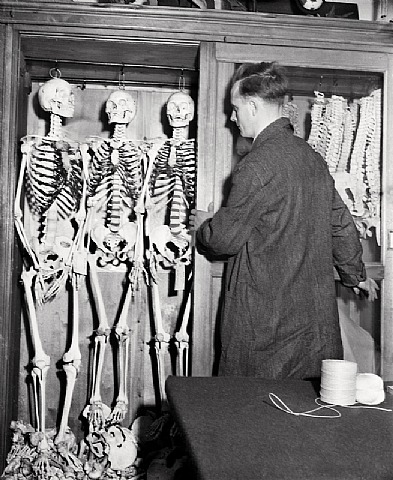Adam, Rouilly is one of the most prominent osteological supply companies of the 20th century. Founded by Guy Rouilly in 1918, this company has made, and continues to make, a substantial impact on the medical teaching supply industry.

Guy Rouilly was the son of a French immigrant to England, Emile Rouilly. Emile Rouilly was the owner of a surgical instrument company, but had his start selling architectural products for Maison Fontaine. Emile Rouilly & Sons was listed as a bronze chasing company first, meaning they hammered out bronze products after they were cast. They then turned to metal work for artists, before settling on surgical instruments. Given this history of metal work, when the Rouilly family finally switched to skeleton preparations in 1918, it was a continuation of their metal craft being honed in the application of hardware to bone. Because Guy was conscripted into the French Army in 1913 for the beginning of World War I when he was 20 years old he only rejoined his father’s company after the war. He worked with his father for six short months before his father passed away in 1920 at age 53.

During this time the company seems to have been run by Emile as Emile Rouilly & Sons, but the name Adam, Rouilly & Co. also appears to have been used. The “Adam” of Adam, Rouilly seems to be a point of contention in company history. A story that persists is that when Guy took over from Emile, a man named Mr. Adam was involved, and then disappeared. The company thinks that this story is less likely than the other explanation, which was using the name Adam to boost the company’s profile in alphabetically ordered trade listings. By using a name with the letter “A,” the company appeared higher up than when listed as “Emile Rouilly & Sons.”
In the 1920’s is when Adam, Rouilly truly began to dominate the osteological trade. Because of the background in metal work, Adam, Rouilly’s skeletons were finely articulated. Because medical schools required students to purchase half-bone sets, many Adam, Rouilly boxes containing one side of the skeleton and a skull can be found in medical collections today. By partnering with Sanker Sen of Reknas (“Sanker'' spelled backwards) in Calcutta, India, Adam, Rouilly was able to provide high-quality skeletons to western customers over the course of a decades-long partnership. Guy Rouilly is said to have personally inspected each skeleton before its shipment. This partnership ended when the exportation of skeletons from India was made illegal in 1985.

Because Guy Rouilly sought to have a wide variety of products, the company also turned to wax, paper maché, plaster, and eventually to plastic medical models. Wax became the most popular material due to its durability. They developed many iconic medical models such as the Bedford Doll which is used to teach nursing, the X-ray doll, and many illustrated diagrams. Guy Rouilly partnered with many different makers to provide medical models such as diaphonized specimens, made by the inventor of the process, Professor Werner Spalteholtz. Adam, Rouilly also fostered a strong partnership with Somso, a German company named for the owners the Sommers, and their town of origin, Sonneberg, Germany. This partnership continues, and together the companies produce many medical models.
When Guy Rouilly retired in the 1960’s, his company had grown from a small metal working shop to a large medical teaching supply company, with a showroom in London, international distributors, and a world-class reputation.

Today, the company has moved away from genuine osteology, focusing on models and developing teaching tools in step with modern medicine. The company celebrated its centennial birthday in 2018, and continues to be at the forefront of medical education supplies today.
We are lucky to have several examples of Adam, Rouilly’s specimens in our showroom. As a company with over a century of history, the evolution of the products, iconography, and mission is interesting to witness. Though Adam, Rouilly’s history is well documented, the products from their osteological division often are undated. By using catalogues, preparation, and logo dating, we are able to give approximations of the history of specimens in our collection. Bone history is often hidden, with most people knowing the origins of the bones, but not what happened after they were shipped to the West. Here at JonsBones we believe in uncovering the truth of the bone trade to help expand the knowledge of the public.


.jpg)



